Nexus S and Android 2.3 Review: Gingerbread for the Holidays
by Brian Klug on December 14, 2010 4:08 PM EST- Posted in
- Smartphones
- Samsung
- Nexus S
- Gingerbread
- Android 2.3
- Mobile
Baseband and Cellular
On the far left side of the Nexus S is another region with the indicative flex/tape appearance that belies an antenna. From experimentation, this region is for WiFi and Bluetooth. The active region for the cellular region is at the very bottom of the Nexus S, as it is with the overwhelming majority of other phones.
We ran our normal suite of attenuation tests on the Nexus S and compared to the rest. The Nexus One had a mini antennagate of its own back when it came out, no doubt Google and Samsung both wanted to avoid a similar situation with the Nexus S. The table says it all - attenuation from holding the device is in line with the 15 dBm or so we’re used to seeing. There aren’t any attenuation issues with the Nexus S.
| Signal Attenuation Comparison in dB—Lower is Better | |||||||
| Cupping Tightly | Holding Naturally | On an Open Palm | |||||
| Nexus S | 13.3 | 6.1 | 4.3 | ||||
| Samsung Fascinate | 10.0 | 5.0 | 0.0 | ||||
| Droid 2 | 11.5 | 5.1 | 4.5 | ||||
| BlackBerry Torch | 15.9 | 7.1 | 3.7 | ||||
| Dell Streak | 14.0 | 8.7 | 4.0 | ||||
| Droid X | 15.0 | 5.1 | 4.5 | ||||
| iPhone 4 | 24.6 | 19.8 | 9.2 | ||||
| iPhone 3GS | 14.3 | 1.9 | 0.2 | ||||
| Nexus One | 17.7 | 10.7 | 6.7 | ||||
I did notice however that the Nexus S likes falling back to EDGE from UMTS and HSPA a whole lot. I’ve only had a limited time to play with T-Mobile’s 3G turned 4G network, so I’m not crying foul, but I did notice that voice calls often migrate over to EDGE if you’re in marginal (but not awful) UMTS coverage, and data does the same from time to time. During my battery life call tests, I had to re-initiate the call three times due to the Nexus S falling from UMTS (3G) voice to GSM and not wanting to pollute data. Signal in my office is admittedly on the lower end at -91 dBm, but still within an acceptable range. The phone will automatically hand back on to UMTS, then to HSPA after a while, but the fallback to EDGE seems much more aggressive than I’ve ever remembered any device being.
I’ve run over 100 speedtests in the short three or so days I’ve had the Nexus S in my HSPA+ enabled T-Mobile market. I saw maximum throughput of 5.1 megabits/s down, 0.64 megabits/s up and average speeds of 2.55 megabits/s down, 0.51 megabits/s up over that time using the Speedtest.net application to a sever in the same city.
The Nexus S is a tri-band HSPA device and quad-band GSM device as shown in the table above. Just like the launch-day Nexus One, the Nexus S won’t work on any 3G in the USA except T-Mobile. You’ll get EDGE if you stick an AT&T SIM inside.
| Nexus S - Network Support | |||||
| Tri-Band HSPA | 900 / 1700 / 2100 MHz | ||||
| Quad-Band GSM/EDGE | 850 / 900 / 1800 / 1900 MHz | ||||
| HSDPA/HSUPA | 7.2Mbps / 5.76Mbps | ||||
When the Nexus One came out - before I signed on with AnandTech in this capacity - I wrote that the problem with the Nexus One concept was that the hardware didn’t have a pentaband UMTS radio. The promise was completely carrier-agnostic phone shopping, yet the only choice you could get with 3G UMTS/HSPA support was T-Mobile. Of course, an AT&T version came later, but the problem remained - hardware wasn’t carrier agnostic, so how could the promise ever be a reality? I’m disappointed that the same thing applies to the Nexus S, although this time around there’s no guarantee we’ll get an AT&T version at all. There are obvious engineering challenges to building pentaband UMTS/HSPA hardware, but if Nokia can do it with the N8 and a select few other phones can pull it off, it can’t be that hard.
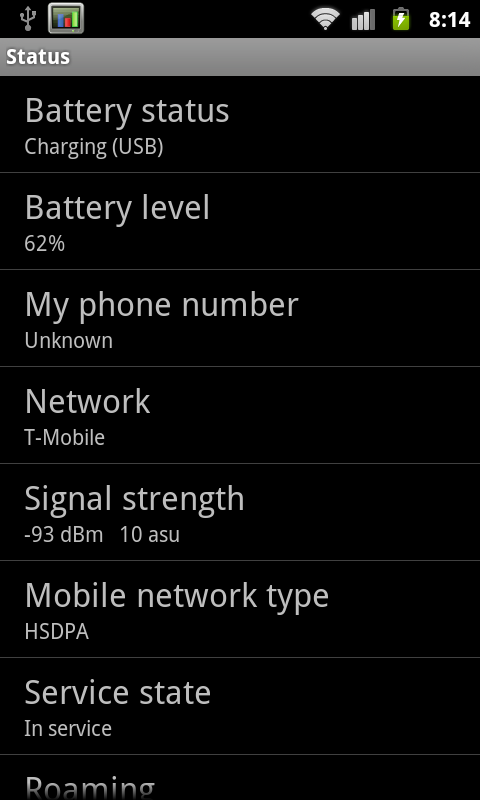
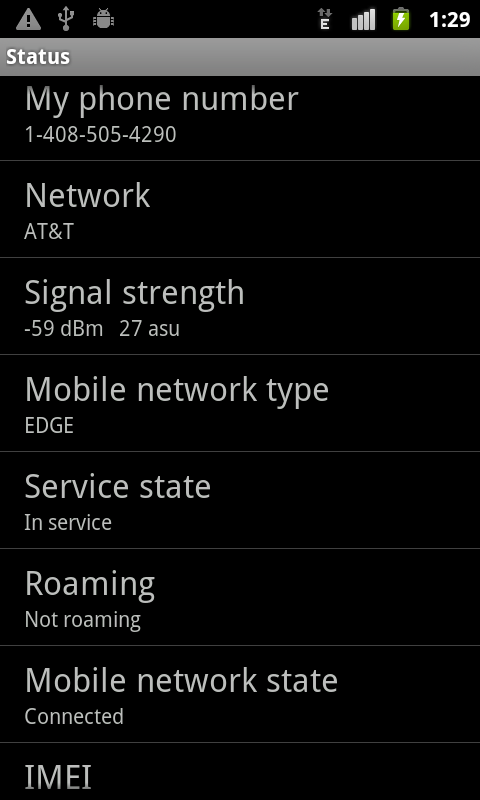
The other thing on everyone’s mind is how much HSPA+ 21.1 differs from HSDPA 7.2 or 14.4 in practice. Well, I’ve been sitting on a myTouch 4G for a while waiting for some T-Mobile service to test with, and in comes a Nexus S with a T-Mobile SIM card. Naturally, I carried the two with me and ran tests at almost the same places. The results are pretty interesting. On the myTouch 4G, I saw maximum throughput of 7.18 megabits/s down, and 0.66 megabits/s up, with an average of 2.75 megabits/s down, and 0.56 megabits/s up.
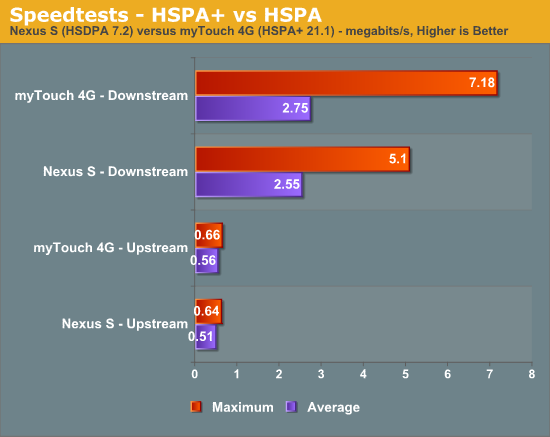
The subtle difference in most cases actually makes sense. The difference between HSDPA 14.4 and HSPA+ 21.1 is just a change in modulation from 16-QAM to 64-QAM. The symbol rates for those two are the same, they just differ in the modulation scheme by a factor of 4 more decision points. Since 64-QAM requires better SNR over 16-QAM, we really only see that modulation scheme when we’re close to the tower. When that’s the case and SNR is really good, HSPA+ of the 21.1 sort does pay off, and you get impressive speeds such as that 7.18 megabit/s speedtest. However, when you’re even just half way out of the cell radius, SNR is most likely no longer good enough for 64-QAM to maintain an acceptable frame error rate, and you’ll fall back to 16-QAM just the same. In reality, HSPA+ only becomes super interesting when MIMO is added into the picture, and even moreso when dual-carrier links are added. MIMO lets us multiplex the signal spatially, and multi-carrier effectively aggregates carriers together for a faster link.
WiFi range on the Nexus S is what I’m used to seeing for smartphones. I make it to the same place right at the curb with the Nexus S as I do other devices. The Nexus S has 802.11 n/b/g support, and I saw it connect at 72 megabits/s on my 802.11n network. In testing, the Nexus S downloaded our local 100 MB PDF over at 15 megabits/s over WiFi.
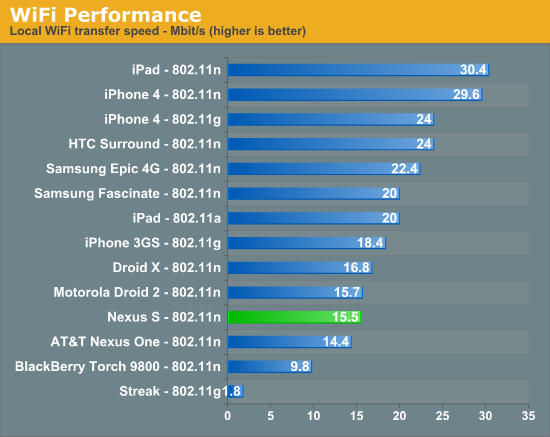
Rounding out this section is a note that the Nexus S suffers from none of the GPS issues that plague the Galaxy S. I tested thoroughly - fixes are fast and accurate over GPS and work like they should using Google location services with WiFi trilateration.


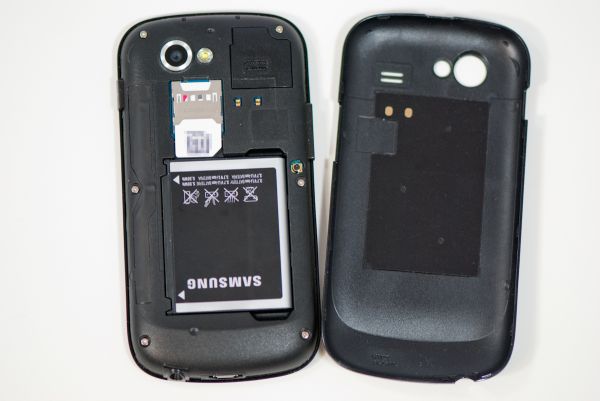
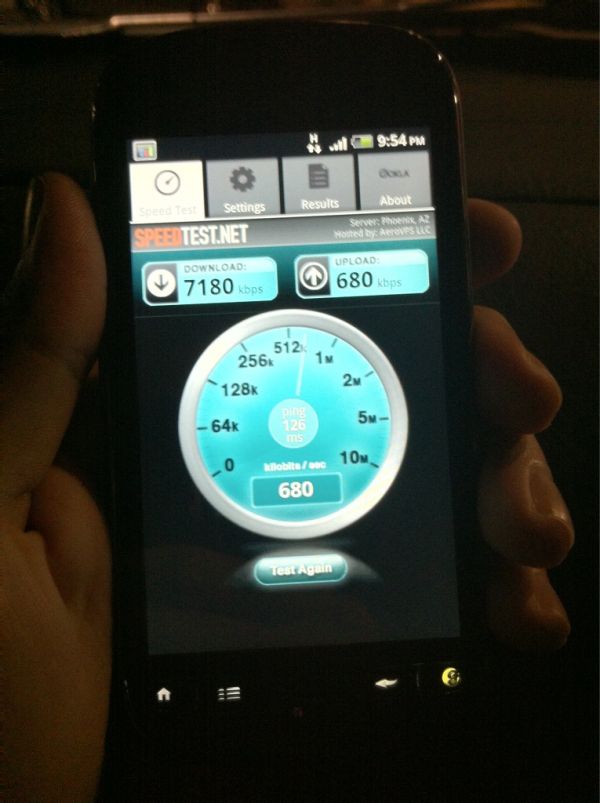








73 Comments
View All Comments
metafor - Wednesday, December 15, 2010 - link
That's a bit misleading. There are a few versions of the "lagfix" around and not all of them simply change the filesystem. A bunch actually turn on memory caching, which essentially uses DRAM to cache disk IO.This is what causes the gigantic jump in Quadrant scores you see. In reality, while the fileIO portion of quadrant does artificially lower the Galaxy S's end-score, it's nowhere near by the amount many who apply the patch sees.
daveloft - Wednesday, December 15, 2010 - link
I'm running 2.2 which boosted my score from 800 - 1100.I also use a lagfix to change my file system to EXT4 which boosted my score from 1100 - 1600.
It's by no means misleading. I know there's lots of other lagfixes and optimizations and custom kernels. It doesn't take away from my point that Quadrant is heavily influenced by file system and as a result of running a different file system on my Galaxy S I a significantly boost in my score.
daveloft - Wednesday, December 15, 2010 - link
The people touting their 2000 plus scores on their Galaxy S are the ones likely doing what you said. But again that comes back to my point that modifying your phone for better IO performance will make your Quadrant score significantly better and any device with really fast storage will benefit from a high Quadrant score. This will lead people to say that the Snapdagron chip is better.metafor - Thursday, December 16, 2010 - link
A lot of people make a lot of claims without isolating the chip. I remember the "A4 vs Snapdragon" and all the wild conjecture that went into that.As for the original comment, I think at least the 45nm Snapdragons are comparable, almost indistinguishable from the current gen Hummingbirds. With the exception of perhaps the FP/SIMD performance -- which no programs today use anyway.
One thing I would like to see is someone try to test these chips for power usage in isolation. A Hall-style current monitor and an integrating voltage monitor should be sufficient to know just how much power these chips use. Of course that means taking the device apart and still have it operating.
zorxd - Tuesday, December 14, 2010 - link
Works just fine here with android 2.2. WPA2+PEAP+MSchapv2Brian Klug - Tuesday, December 14, 2010 - link
So I think the story with the Nexus One was that it was working in 2.2, but disappeared in 2.2.1. I know that for some months now I've been unable to authenticate with that same network with the Nexus One.Some of the other devices have better WPA supplicants too I guess.
-Brian
Shadowmaster625 - Tuesday, December 14, 2010 - link
If you phone is laying on a book, the camera lens is about 3 mm away from the page and the viewing angle is about 3 of those letters. Not to mention there is no light getting under there. So how can the screen be showing all those characters?Brian Klug - Tuesday, December 14, 2010 - link
Oh so when I took that photo, I was worried someone would be misled, apologies, didn't mean to confuse. I just took a photo a few inches from the page, then set it as the wallpaper, then snapped the picture.What's being shown isn't camera input. ;)
-Brian
sabrewulf - Tuesday, December 14, 2010 - link
"Things like scrollback and sending cursor commands in connectbot (arguably Android’s best SSH application) simply require having some directional controls - there’s no virtual keyboard with arrow keys. "Using the Swype keyboard, if you swype from the swype button to the sym button and release, you are given a virtual keyboard with arrow keys, pgup/dn, home/end, and a few other functions.
Brian Klug - Tuesday, December 14, 2010 - link
Oh wow, I totally missed that in Swype. Awesome tip!-Brian